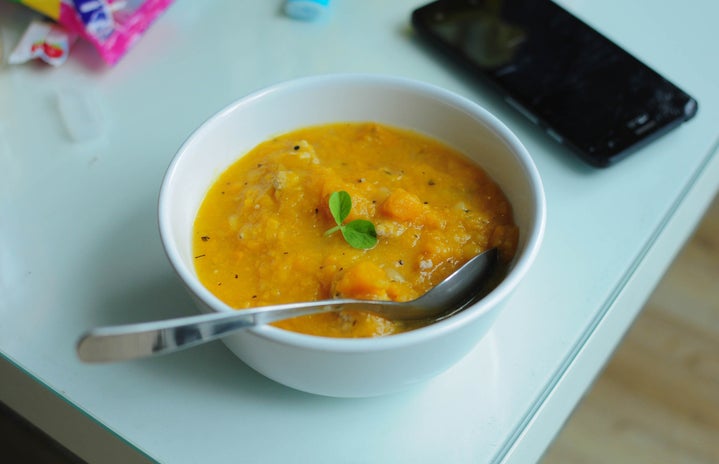During my senior year in high school, I became obsessed with a famous curry restaurant in Sangenjaya. Although the restaurant offered authentic Indian curry, many restaurants in Japan serve a plate of unique curry using the power of spices. Over the summer, I have visited quite a few curry restaurants, so I will be introducing five recommendations along the Chuo Line.
- Santosham (三燈舎) @Ochanomizu
-
On a hot Sunday afternoon, I went to Santosham to see about 12 people waiting in line. As I waited for 15 minutes, I was able to go into the restaurant to see the calming white interior. There were primarily female customers sitting at tables and counters. I ordered “Santosham Meals,” a lunch set on the weekends, and homemade lassi, a blended yogurt drink, on the side. Many readers may imagine Indian cuisine as naan and creamy curry, which is Northern Indian food, but this restaurant serves Southern Indian cuisine such as soup-like curry with rice. “Santosham Meals” served four different kinds of curry, such as chicken, fish, and vegetables with rice and bhatura. The curries had a lovely scent of spice and sourness, and it was even more delicious mixing different curries onto the rice. I highly recommend Santosham if you want to try Southern Indian food.
- Yoshida Curry (吉田カレー) @Nishi-Ogikubo
-
Only one person runs this famous restaurant located in Nishi-Ogikubo. Since it is so busy, the chef sets out rules for customers to follow; do not sit at the table unless you are told to, the chef will ask for the order, the chef will guide you to the table seats when available. Many customers were there by themselves with a mix of men and women. Keema curry is the only kind of curry it serves, but there are multiple toppings to choose from that occasionally change. I ordered Keema curry with pork and cheese as toppings. The curry is based on vegetables and fruit such as tomato and banana, having a gentle and refreshing taste with a pinch of spice. Another feature of Yoshida curry is that it is gluten-free, additive-free, and does not contain artificial flavoring. If you are interested in exploring unique curry, try Yoshida Curry!
- Sajilo Cafe (サジロカフェ) @Kichijoji
-
Some readers may have heard of this restaurant since it trended on social media. When I went to Sajilo Cafe on a hot summer day, quite a few young customers were waiting in line. Not only did Sajilo Cafe have a wide variety of curries, from chicken to dal curry, but they also served their signature dish, cheese naan. They serve a lot of cheese naan, so I can guarantee that you will be full and satisfied by the end of the meal. Although it was a bit overcrowded, I recommend trying the cheese naan and delicious curry with a friend.
- Mamezo (まめ蔵) @Kichijoji
-
If you are ever in Kichijoji and craving good curry, you should visit Mamezo to try their European curry. The restaurant opened in 1978, looks like an old-fashioned coffee shop since it is made out of bricks. Mamezo uses curry roux stewed for three days with red wine and ten different spices that have not changed since its opening. There was a wide variety of curry as well as toppings priced around one thousand yen. I ordered chicken curry with no toppings, and I enjoyed eating the flavorful curry in a peaceful atmosphere. Next time, I would come here again to enjoy the curry and relax with a friend.
- Pooh (カレーのお店プーさん) @Musashi-Koganei
-
I entered the restaurant on a rainy day, but the seats were packed with customers eating away their dishes. The restaurant name, Pooh, seems like a funny choice, but the owner named it to make it easier for female customers to enter the restaurant. As soon as I saw the curry, my first impression was the vibrant color on the curry. Although I ordered mutton curry, there were many vegetables such as eggplant, baby corn, edamame, and spinach with a few different kinds of mushrooms. Also, they use
broth from dried bonito, shiitake, and kombu which brings out the umami, so they use a moderate amount of salt. Surprisingly, they also do not use any oil so that you can finish the curry with ease. If you are ever in Musashi-Koganei, I highly recommend trying the curry to fulfill your appetite.
Lastly, if you are interested in visiting the restaurants, be sure to check out their social media for the latest information!


